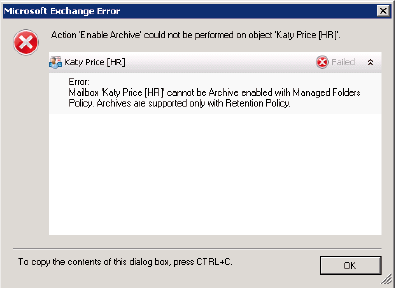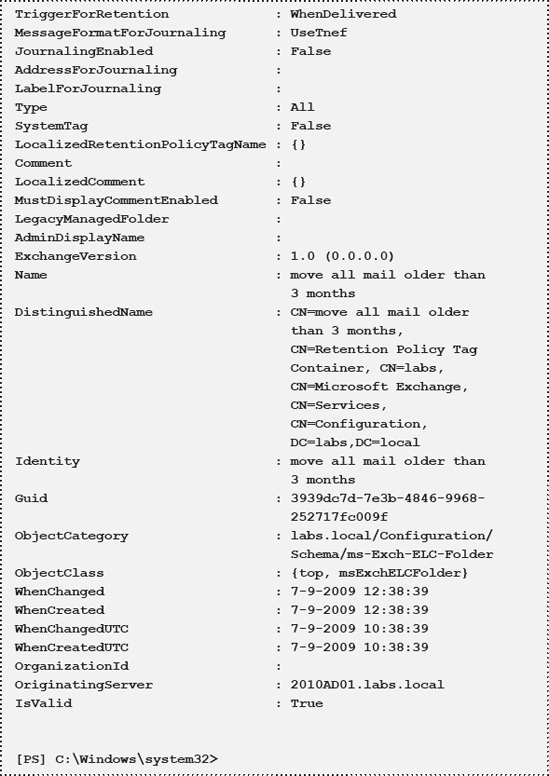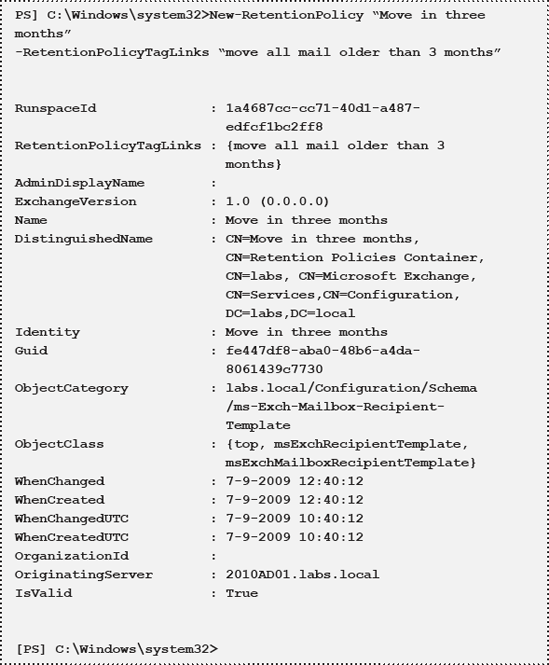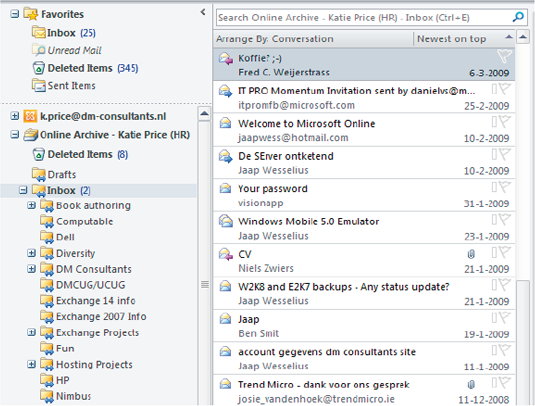2 Messaging Records Management
Messaging Records Management (MRM) policies in
Exchange Server 2010 are comparable to rules in an Outlook client. With
these policies, an Exchange Administrator has the ability to automate
the processing of email and simplify message retention. Examples of
reasons for implementing MRM rules are things like: your company needs
to comply with requirements from Sarbanes-Oxley (SOX), the Health
Insurance Portability and Accountability Act (HIPAA), or the US Patriot
Act.
With Messaging Records Management it is possible to:
One way to implement MRM is by using "Managed
Folders," which involves an Exchange Administrator creating one or more
custom folders and an associated custom folder policy. This policy can
be responsible for, as an example, messages being deleted after 180 or
360 days, but the user is still responsible for moving the individual
messages to the custom folder.
NOTE
Managed Folders and an
Archive Mailbox are not compatible. If you are using Managed Folders on a
particular mailbox and you want to create an Archive, the creation will
fail:

You have to migrate the Managed Folder solution to a Retention Policy solution before implementing an Archive Mailbox.
New in Exchange Server 2010 is the implementation of
MRM using "Retention Policies" and "Retention Tags." Retention Tags
specify if retention is enabled, how long a message (which can be a note
or a contact as well) should be retained, and what action will be
performed when the retention age is reached. Messages are processed by
the Exchange Mailbox Server based on the retention tags and those tags'
content settings. When a message reaches the retention age limit
specified in the tag, it can be archived, deleted, or flagged for user
attention.
Using Retention Policies, it is now also possible to
store only messages with a maximum age of 3 months in the user's
mailbox, and store messages older than 3 months in the Archive Mailbox.
Suppose there's a Human Resources department within your organization,
and all messages older than 3 months should be stored into the user's
Archive. The following steps have to be followed:
Create the necessary Retention Tags which
define when an action should be taken (i.e. when the retention time of 3
months have passed).
Create the Retention Policy that defines what needs to be done when the retention time has passed (i.e. move to the Archive).
Apply the policy to the mailbox.
Creating the Retention Tags and the Retention Policy cannot be done with the Exchange Management Console, only
with the Exchange Management Shell. You'll need to open the Management
Shell and enter the following command to create the Retention Tag:

When the tag is created, the results will be shown immediately:


[Edited for readability]
The next step is to create the actual policy that defines what RetentionTags are included with this policy:

Again the results will be shown immediately:

[Edited for readability]
Now the policy with the retention tags needs to be
applied to the user's mailbox, in our example, Katy Price from the HR
department, and the Managed Folder Assistant needs to be started. To do
this, enter the following commands:

When the Managed Folder Assistant has finished
applying the policy, you can check the mailbox and its archive. For the
user "Katy Price" in our example, the mailbox has shrunk from 1.5 GB to
"only" 430 MB. The remaining 1.1 GB of mail data has been moved to the
archive.

The Managed Folder Assistant is running on the
Mailbox Server where the user's mailbox resides. To change the schedule
when the Managed Folder Assistant runs, open the properties of the
Mailbox Server in the Exchange Management Console and go to the
Messaging Records Management tab. Be careful when you schedule the
Folder Assistant to run, especially when a lot of mailboxes are
initially managed, and a lot of data needs to be moved.
In that situation, the Managed Folder Assistant will consume quite a lot of resources very quickly.
When creating the Retention Policy Tag using the
New-RetentionPolicyTag, the –RetentionAction parameter defines what
action needs to be taken when the policy comes into play (In our
example, the "MoveToArchive" was selected). The following options are
available for the –RetentionAction parameter:
move to archive
move to the Deleted Items folder
delete and allow recovery
permanently delete
mark as past retention limit.
Whether the tag applies to the entire mailbox or a
specified default folder is determined by the tag's Type property. You
can create default policy tags of the following types:
All
Calendar
Contacts
DeletedItems
Drafts
Inbox
JunkMail
Journal
Notes
Outbox
SentItems
Tasks
RssSubscriptions
SyncIssues
ConversationHistory